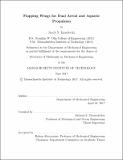Flapping wings for dual aerial and aquatic propulsion
Author(s)
Izraelevitz, Jacob (Jacob Samuel)
DownloadFull printable version (32.98Mb)
Other Contributors
Massachusetts Institute of Technology. Department of Mechanical Engineering.
Advisor
Michael S. Triantafyllou.
Terms of use
Metadata
Show full item recordAbstract
Ocean sampling for short-transient underwater phenomena, such as harmful algal blooms, necessitates a vehicle capable of fast aerial travel interspersed with an aquatic means of acquiring in-situ measurements. Vehicle platforms with this capability have yet to be widely adopted by the oceanographic community. The primary difficulties in creating such a vehicle, despite the identical governing equations in the two uid media, is a viable propulsion design that can deliver the wide range of forces required. However, several bird species (including murres, puns, and other auks) successfully achieve dual aerial/aquatic propulsion using a single set of flapping wings, offering an existence proof for favorable ow physics. Flapping wings thereby demonstrate a large force envelope, with capabilities far beyond the limits of static airfoil section coefficients, purely by changing the wing motion trajectory. The wing trajectory is therefore an additional design criterion to be optimized along with traditional aircraft parameters, and could open the door to dual aerial/aquatic robotic vehicles. In this thesis, I discuss multiple realizations of a 3D flapping wing actuation system for use in both air and water. The wings oscillate by the root, and employ an active in-line motion degree-of-freedom. I analyze two types of motions in detail: `aquatic' motions where the wing tip moves downstream during the power stroke of each flapping cycle, and `aerial' motions where the wing tip moves upstream during the power stroke. These types of wing motions are common throughout biology, including auks, in order to enhance aerial lift or provide better control over underwater thrust. By controlling the dynamic wing twist and stroke angle, I demonstrate in experiments the necessary force envelope required for dual aerial/aquatic flight. Additionally, I elucidate the wakes of these complex wing trajectories using dye visualization, correlating the wake vortex structures with simultaneous force measurements. To inform the design space, I also analytically derive a low order state-space adaptation of the unsteady lifting line model for flapping or maneuvering wings of finite aspect-ratio. This nonlinear model is suitable for use in the real-time control of wake-dependent forces, without requiring a detailed memory of the wake. Predictive ow states are distributed over the wingspan, providing local information of the instantaneous wing loading, circulation, and wake. I validate this state-space model against both unsteady vortex lattice methods and experiments from the literature. Finally, I optimize the dual aerial/aquatic apping wing trajectories using the state-space model. This experiment-coupled optimization routine minimizes parasitic oscillation of the wing force, allowing control of the unsteady forces throughout each apping cycle. After optimization, the wing trajectories generate the large force envelope necessary for propulsion in both uid media, and furthermore, demonstrate improved control over the unsteady wake.
Description
Thesis: Ph. D., Massachusetts Institute of Technology, Department of Mechanical Engineering, 2017. This electronic version was submitted by the student author. The certified thesis is available in the Institute Archives and Special Collections. Cataloged from student-submitted PDF version of thesis. Includes bibliographical references (pages 167-177).
Date issued
2017Department
Massachusetts Institute of Technology. Department of Mechanical EngineeringPublisher
Massachusetts Institute of Technology
Keywords
Mechanical Engineering.